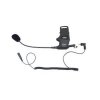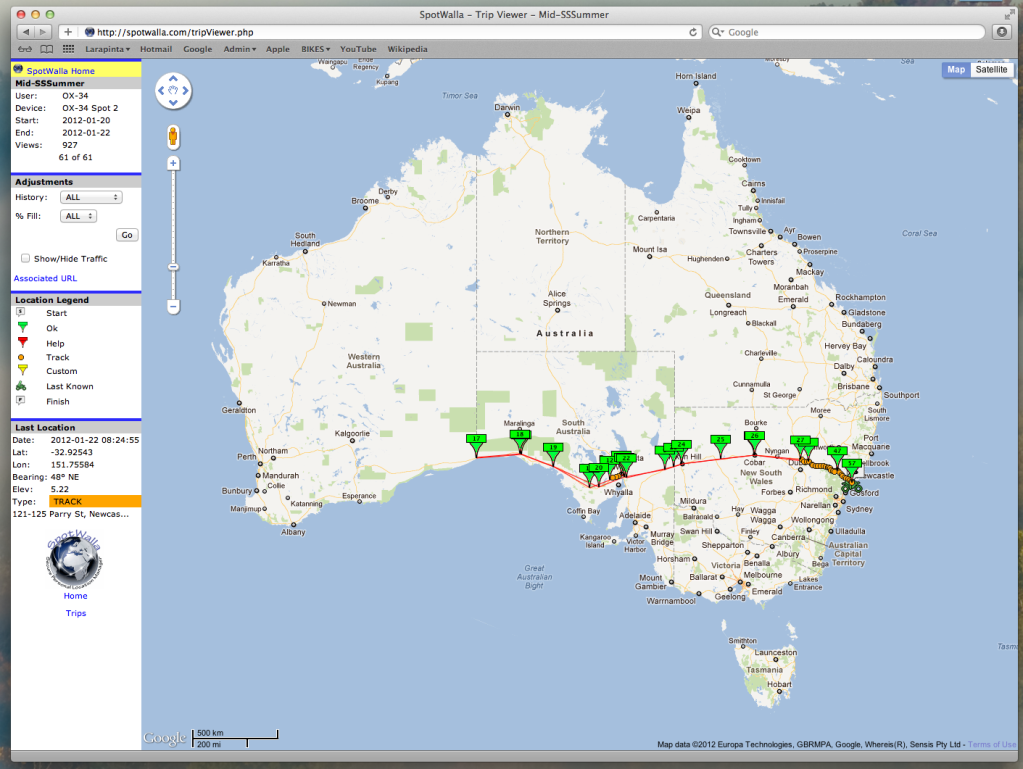I've been riding for 45+ years (street & dirt), desert raced in AMA D37 and have almost 1,000,000 miles on street bikes. The greatest being almost 103,000 miles on my 1985 GL1200 Aspencade in one year. So I am used to long days, but these Iron Butt Association (IBA) rides are different.
Did my first this past June (a SaddleSore 1000 - i.e. 1,000 miles in 24 hours). That was easy, not much planning required since you have alot of 'extra' time if riding Interstates out west. I am sure it is harder in more congested areas.
I just finished a Bun Burner Gold this past Tuesday (1500 miles in 24 hours) and this took some real route planning. You have to average 62.5mph for 24 hours just to cover this distance - and that is with no stops. I wanted to maximize my route on higher speed interstates vs. slower two-lane roads, but I am a minimum of 100 miles away from any interstates, which can be clogged with tourist traffic, with limited passing lanes. This means avoiding the weekends and even daylight hours.
Since my route would take me thru Reno, Salt Lake City and Las Vegas I also needed to stage my route timing to avoid these areas during rush-hour traffic. This set me leaving time to around 4am to get thru these areas. To get a feel for possible traffic in areas that I am not familiar with, I use the online Google Maps and turn on the 'traffic' function. I monitor the traffic for a few days to get a idea of when traffic starts to build and go away.
I also wanted to plan my fuel stops at stations located right at the off-ramps and avoiding as much surface streets as possible. I also had to make sure that the stations I planned to use would be open at the hours I would be hitting them. That is a real concern if traveling thru rural Oregon at night, as you cannot self-fuel and when the stations are closed, they are really closed. Not to much of a problem with the truck stops I used on the interstates, but was issue with the smaller towns on Highway 395, and even my home town.
I also timed my normal fuel stops to see how much time delay each fuel stop would cost. It took me on average 7 minutes from pulling up to the fuel pump, removing tank bag, getting out credit card (kept handy in a zip-lock bag along with the required IBA stop log), fueling, filling out the log, putting tank back back on (mine is a quick disconnect Marsee - similar to the SW-Motech quick-disconnect), resetting the trip odo and leaving. This was all accomplished without getting off the bike. Since I ended up planning a total of 9 fueling stops this would add at least a hour to my over-all time, increasing my overall moving average to 65mph to do the 1500 miles in 24 hours.
I also checked the various state Department of Transportation sites to see what road construction was taking place and what the delays were. This turned out to be less successful then planned. I could find no indication of the 30+ miles of reduced speed, single lane traffic on I-80 in Nevada. Same for the 4 (or 5) road construction sites on Highway 395 in California, complete with flaggers and flashing road-side signs saying delays of up to 20 minutes per stop! Ugh.
Nor was the 60mph 'safety corridor' on I-15 from around Baker to almost the California/Nevada state line listed. All of these just reduce your moving speed average and you will need to make sure time (by increasing speed) so you do not exceed the 24 hour time limit. Thank goodness for the posted 80MPH sections in Utah, along with hundreds of miles of posted 75MPH sections on I-15 & I-80.
You do not really have time to stop and have a meal. I sipped a Propel during my stops. If it was hotter, I would plumb in a hydration system so I can drink on the move. I have found that just snacking helps me stay awake...nothing like trying to digest a big meal to make you sleepy! I also made sure to really hydrate myself and get enough sleep for several days prior to leaving.
I also found it easier to leave my heated gear jacket & gloved on for the entire trip and turn it off when not needed. I saw temps from a low of 18F to 87F, with no precip. Looking at the weather forecast along your route should not be under-estimated. You will not make good time if it is pouring down rain, snowing, excessively windy, etc. I had planned the trip a few days earlier, but rain, heavy at times, was forecast so I delayed. Luckily I did as the rain turned out to be extremely heavy in some areas that caused intermittent road closures.
Another thing that I got bit by.....at my next to last fueling stop my credit-card got declined. Turned out the 'fraud-protection-team' saw all this suspicious activity from 3 different states and suspended my card. Luckily I have several (and cash) so I got out another card and continued. After getting home I called them and they suggested that i call them ahead of time to let them know to expect this type of activity and they will not suspend it. Lesson learned.
I ended up completing my ride, traveling a total of 1518 miles in a total elapsed time of 23 hours, 12 minutes. My moving average was 71MPH, with a overall trip average of 67MPH. My moving time was 21hours, 25 minutes. Total non-moving time was 1hour, 47 minutes! I had two 'extended stops' for a power-bar and to stretch. Each of those stops (including fuel) were about 15 minutes.
It was a experience.
Maybe the 50CC (Coast-to-Coast in 50 hours) is next!?!
Did my first this past June (a SaddleSore 1000 - i.e. 1,000 miles in 24 hours). That was easy, not much planning required since you have alot of 'extra' time if riding Interstates out west. I am sure it is harder in more congested areas.
I just finished a Bun Burner Gold this past Tuesday (1500 miles in 24 hours) and this took some real route planning. You have to average 62.5mph for 24 hours just to cover this distance - and that is with no stops. I wanted to maximize my route on higher speed interstates vs. slower two-lane roads, but I am a minimum of 100 miles away from any interstates, which can be clogged with tourist traffic, with limited passing lanes. This means avoiding the weekends and even daylight hours.
Since my route would take me thru Reno, Salt Lake City and Las Vegas I also needed to stage my route timing to avoid these areas during rush-hour traffic. This set me leaving time to around 4am to get thru these areas. To get a feel for possible traffic in areas that I am not familiar with, I use the online Google Maps and turn on the 'traffic' function. I monitor the traffic for a few days to get a idea of when traffic starts to build and go away.
I also wanted to plan my fuel stops at stations located right at the off-ramps and avoiding as much surface streets as possible. I also had to make sure that the stations I planned to use would be open at the hours I would be hitting them. That is a real concern if traveling thru rural Oregon at night, as you cannot self-fuel and when the stations are closed, they are really closed. Not to much of a problem with the truck stops I used on the interstates, but was issue with the smaller towns on Highway 395, and even my home town.
I also timed my normal fuel stops to see how much time delay each fuel stop would cost. It took me on average 7 minutes from pulling up to the fuel pump, removing tank bag, getting out credit card (kept handy in a zip-lock bag along with the required IBA stop log), fueling, filling out the log, putting tank back back on (mine is a quick disconnect Marsee - similar to the SW-Motech quick-disconnect), resetting the trip odo and leaving. This was all accomplished without getting off the bike. Since I ended up planning a total of 9 fueling stops this would add at least a hour to my over-all time, increasing my overall moving average to 65mph to do the 1500 miles in 24 hours.
I also checked the various state Department of Transportation sites to see what road construction was taking place and what the delays were. This turned out to be less successful then planned. I could find no indication of the 30+ miles of reduced speed, single lane traffic on I-80 in Nevada. Same for the 4 (or 5) road construction sites on Highway 395 in California, complete with flaggers and flashing road-side signs saying delays of up to 20 minutes per stop! Ugh.
Nor was the 60mph 'safety corridor' on I-15 from around Baker to almost the California/Nevada state line listed. All of these just reduce your moving speed average and you will need to make sure time (by increasing speed) so you do not exceed the 24 hour time limit. Thank goodness for the posted 80MPH sections in Utah, along with hundreds of miles of posted 75MPH sections on I-15 & I-80.
You do not really have time to stop and have a meal. I sipped a Propel during my stops. If it was hotter, I would plumb in a hydration system so I can drink on the move. I have found that just snacking helps me stay awake...nothing like trying to digest a big meal to make you sleepy! I also made sure to really hydrate myself and get enough sleep for several days prior to leaving.
I also found it easier to leave my heated gear jacket & gloved on for the entire trip and turn it off when not needed. I saw temps from a low of 18F to 87F, with no precip. Looking at the weather forecast along your route should not be under-estimated. You will not make good time if it is pouring down rain, snowing, excessively windy, etc. I had planned the trip a few days earlier, but rain, heavy at times, was forecast so I delayed. Luckily I did as the rain turned out to be extremely heavy in some areas that caused intermittent road closures.
Another thing that I got bit by.....at my next to last fueling stop my credit-card got declined. Turned out the 'fraud-protection-team' saw all this suspicious activity from 3 different states and suspended my card. Luckily I have several (and cash) so I got out another card and continued. After getting home I called them and they suggested that i call them ahead of time to let them know to expect this type of activity and they will not suspend it. Lesson learned.
I ended up completing my ride, traveling a total of 1518 miles in a total elapsed time of 23 hours, 12 minutes. My moving average was 71MPH, with a overall trip average of 67MPH. My moving time was 21hours, 25 minutes. Total non-moving time was 1hour, 47 minutes! I had two 'extended stops' for a power-bar and to stretch. Each of those stops (including fuel) were about 15 minutes.
It was a experience.
Maybe the 50CC (Coast-to-Coast in 50 hours) is next!?!






